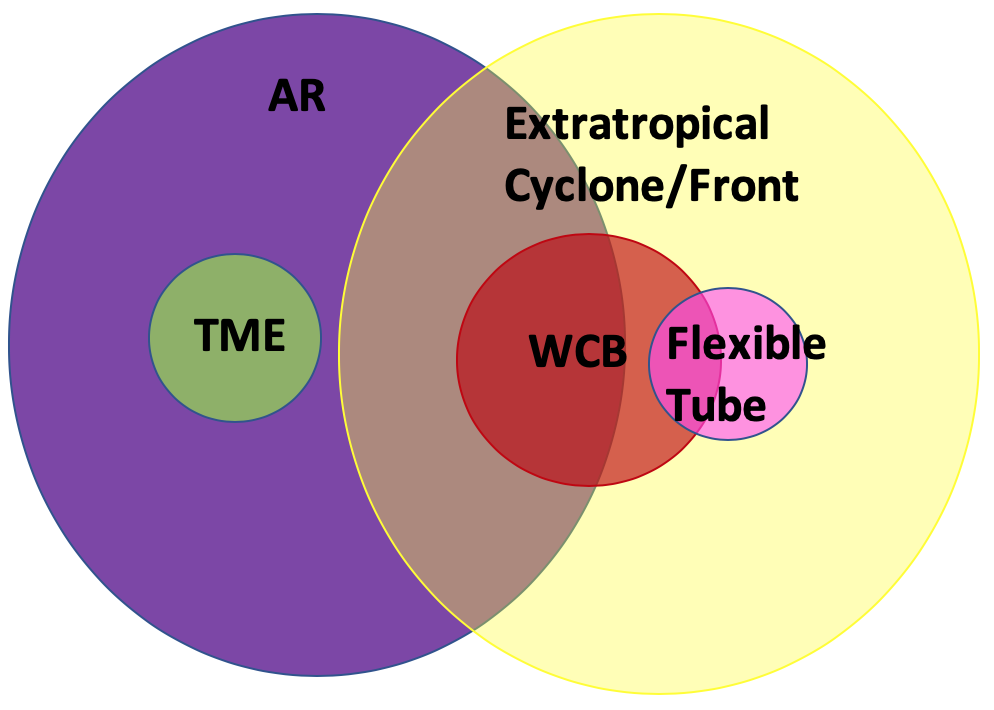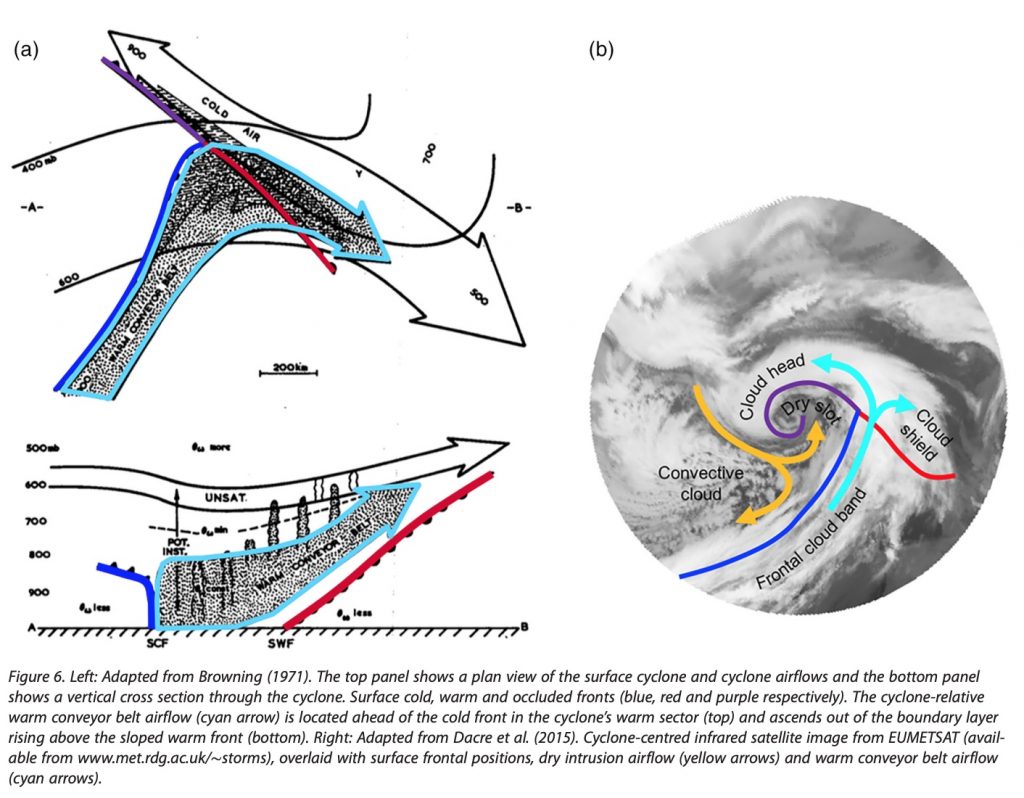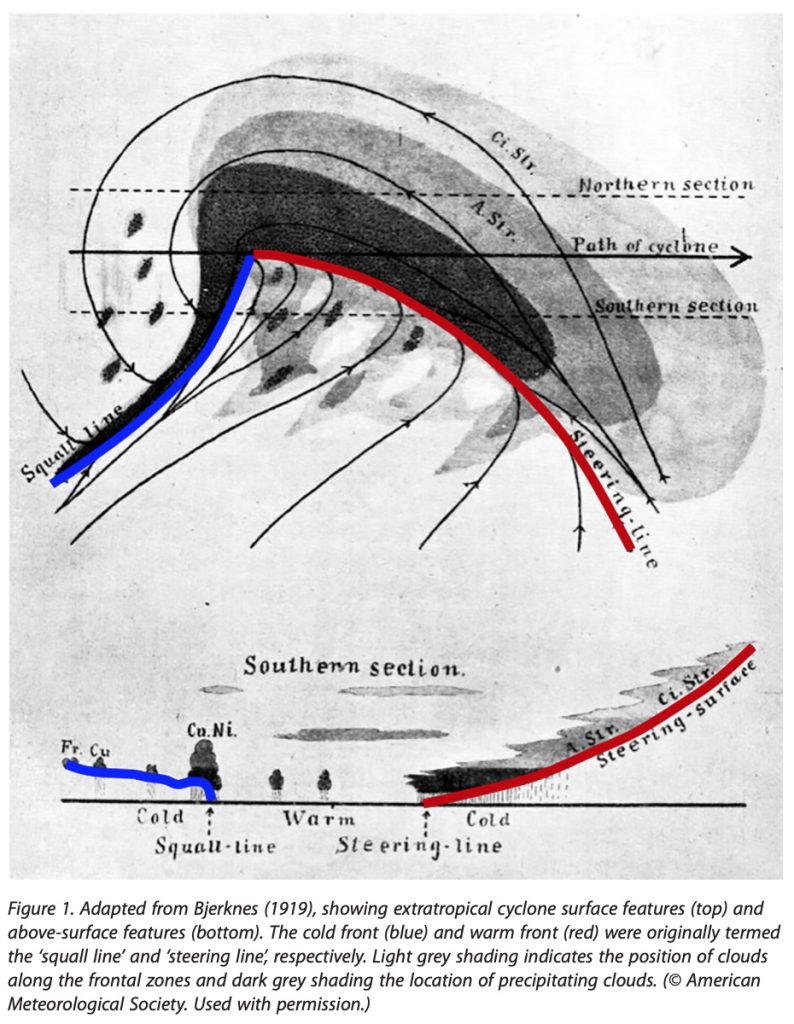Picture: Thunderstorm over fields. Credit: Tobias Hämmer (Pixabay).
by Kim Reid
Front, warm conveyor belt, atmospheric river, tropical moisture exports and flexible tubes. These are just some of the terms used throughout the scientific literature to describe big, long, wet things in the atmosphere. But are these phrases describing different phenomenon or are they merely alternative names for the same system?
Origins of Conceptual Models of Extratropical Cyclones
It has been just over 100 years since Bjerknes’ seminal 1919 paper On the Structure of Moving Cyclones was published. As the satellite era would not begin for another 60 years, scientists used the extensive European telegraph network to attain observations of air pressure, temperature and wind to understand and track the evolution of extratropical cyclones across the continent.
Following World War II and the rapid development of aircraft technology, upper atmospheric observations became available for meteorologists. This allowed for a better understanding of the vertical motion within an extratropical cyclone, and in 1971 Browning introduced the term Warm Conveyor Belt.
The Warm Conveyor Belt is a narrow, quasi-continuous ascent of planetary boundary layer moisture from the warm sector over a warm front in an extratropical cyclone. The warm conveyor belt is illustrated by the light blue lines in the above image. Warm Conveyor Belts are the main region of cloud formation and precipitation in an extratropical cyclone.
Atmospheric Rivers are the topic of my PhD. Atmospheric Rivers were first proposed by Newell et al. (1992) in what was originally an air pollution study trying to understand how large concentrations of carbon monoxide were ending up thousands of kilometres from any likely source. They proposed that these narrow filaments were acting like highways for moisture and pollutants to travel from the tropics to higher latitudes. Atmospheric Rivers are long (>2000km), narrow regions of strong horizontal moisture transport. Average Atmospheric River water transport is comparable to the largest terrestrial rivers on earth, and severe Atmospheric Rivers can cause devastating floods.
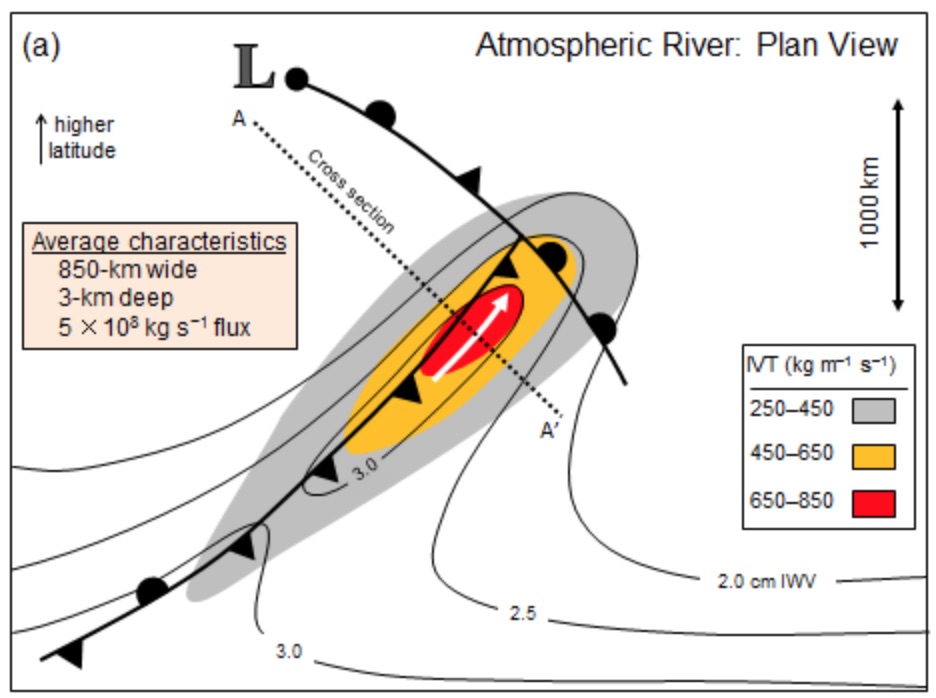
Credit: AMS.

Credit: AMS
Rivers, Conveyor Belts, are they really different?
While they definitely sound similar, and people outside the field would be forgiven for assuming they are the same, they are not the same physical phenomena. In fact, Knippertz et al. (2018) conclude in their analysis of this exact question that, “Atmospheric Rivers and Warm Conveyor Belts are related but by no means identical concepts of atmospheric flow… and must not be used as synonyms.”
Warm conveyor belts are always associated with an extratropical cyclone and are defined in the frame of reference of the cyclone. Atmospheric rivers can exist independently from extratropical cyclones although they can and often do interact with extratropical cyclones and fronts. Sodermann and Stohl (2013) traced moisture particles during a particularly active month of North Atlantic extratropical cyclones (December 2006) and found that contrary to warm conveyor belts, individual atmospheric rivers can be associated with and act as a reservoir for multiple cyclones.
Another key difference is that warm conveyor belts are associated with strong vertical motion from the boundary layer to the upper troposphere. Atmospheric rivers, on the other hand, are typically confined to the lower troposphere and are defined by their strong horizontal motion.
A recent study by Dacre et al. (2019) sought to clarify the relationship between atmospheric rivers and warm conveyor belts via a moisture budget analysis.
They describe the atmospheric river (green arrows in schematic, right) as being responsible for transporting moist air to the base of the warm conveyor belt where it then ascends and forms clouds and precipitation.
Tropical moisture exports and atmospheric rivers are physically the same phenomenon. The difference being that tropical moisture exports must have a tropical connection, while atmospheric rivers can form outside the tropics.
Also, some scientists didn’t like the term ‘atmospheric river’ (e.g. Bao et al., 2006) because it implied that the moisture all originated from the tropics and flowed to the poles. In reality, a significant amount of the moisture in an atmospheric river/tropical moisture export comes from local convergence (Dacre et al 2014).
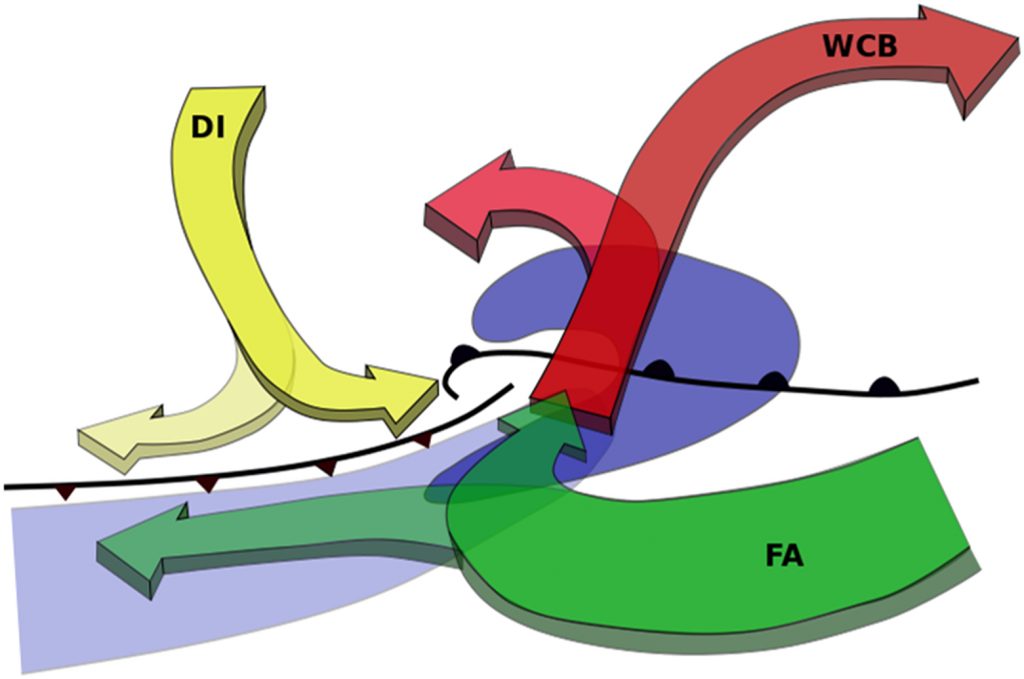
Figure 7 from Dacre et al. (2019) showing a schematic of the cyclone-relative airflows within an extratropical cyclone. FA (‘Feeder Airstream’) represents an Atmospheric River from the reference frame of the extratropical cyclone.
Knippertz and Martin (2007) even used the phrase ‘moisture conveyor belt’ because it fit with the existing conveyor belt model of extratropical cyclones.
Flexible tubes was a term coined by Wernli in his Lagrangian-based analysis of a North Atlantic extratropical cyclone during November 22-24, 1992. These tubes represent vertical paths or, as Wernli described them, the ‘river beds’ for boundary layer moisture to ascend in an extratropical cyclone i.e. like the river bed for a warm conveyor belt. The phrase flexible tubes never really caught on, but the idea of thinking about warm conveyor belt as an ensemble of parcel trajectories remained.
As the schematic (right) illustrates, the relative motion (and densities) of the warm and cold air result in a region of instability and often precipitation along the frontal boundary.
Fronts and warm conveyor belts, and fronts and atmospheric rivers are not the same, but they are often co-occurring as most of the diagrams in this blog show.
Warm conveyor belts ascend along the warm front of an extratropical cyclone-front system and atmospheric rivers feed moisture from afar into the system but can also exist independently of fronts and cyclones.
To summarise, here is a Venn diagram showing the co-occurrence of the systems mentioned in this piece. All tropical moisture exports are atmospheric rivers. All warm conveyor belts and flexible tubes occur within extratropical cyclones and fronts.
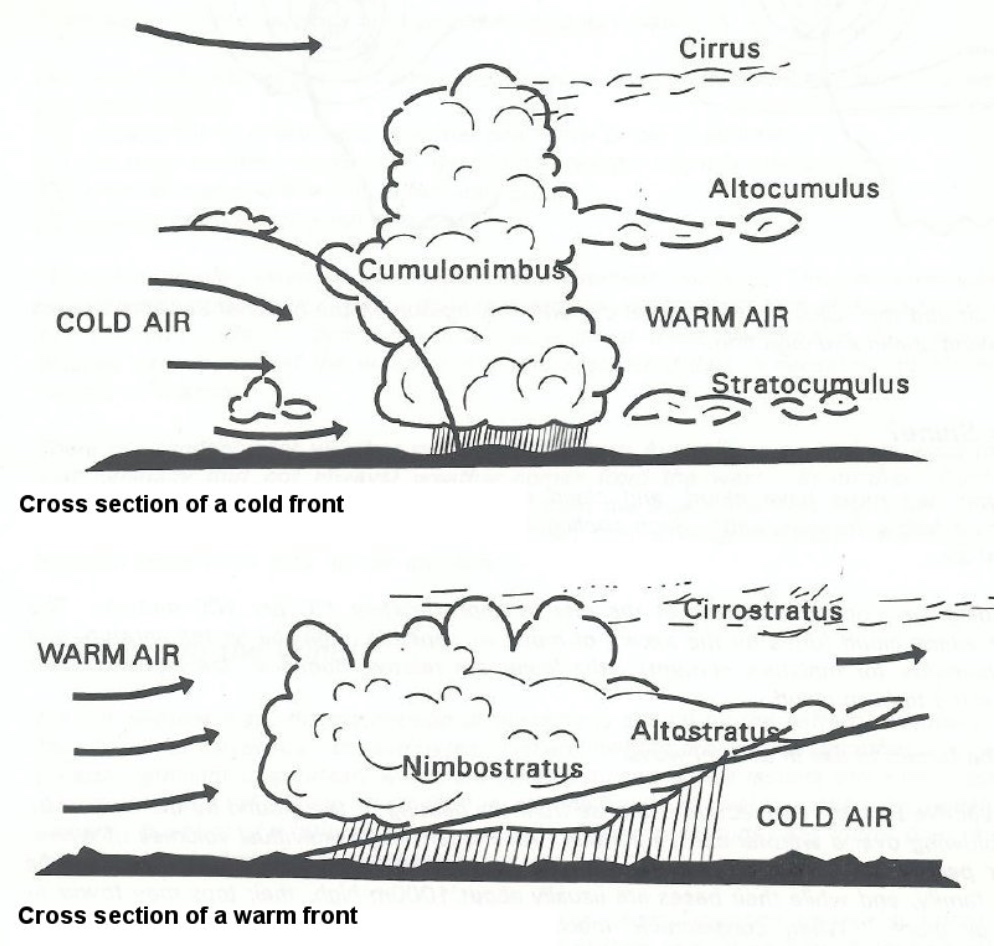
Some flexible tubes are warm conveyor belts. Some atmospheric rivers occur as part of extratropical cyclones and fronts. All are exciting areas of research that impact our way of life.
